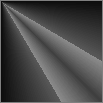|
Jumaane Jeffries
- Problem Set #2
| ||
|
Part 1 |
 p1.dbn p1.dbn |
// PS #2-1
Paper 75
Repeat A 0 40
{
Pen (75 - (3*A)/4)
Line 0 100 100 A
Line 0 100 (100-A) 0
}
Repeat A 41 100
{
Pen (45 + (A/2))
Line 0 100 100 A
Line 0 100 (100-A) 0
}
|
|
Choose a single shade of a paper and render that shade.
| ||
|
Part 2 |
p2.dbn |
// PS #2-2
// Flickering diamond
Repeat A 0 100
{
Paper A
Repeat B 0 (A/10)
{
Pen (A*A*A*A/1000000)
Line (50 - (2*B)) 50 (50+B*(37+B)/94) (50 + (4*B))
Line (50+(37+B)*B/94) (50 + (4*B)) (50 + (B*B)/5) 50
Line (50 + (B*B)/5) 50 (50-B) (50 - (B*B*B)/75)
Line (50-B) (50 - (B*B*B)/75) (50-(2*B)) 50
}
}
|
|
Create a sequence of shaded papers using the Repeat command as a short
animation of brightness. For example Repeat a 0 100 { Paper a } | ||
|
Part 3 |
p3.dbn |
// PS #2-3
// Chemical Fadeaway Beats
Repeat B 4 20
{
Repeat A 0 25
{
Paper ((16*A)/B)
}
}
|
|
Create an animation of a sequence of shaded papers that evokes a sense of rhythm.
| ||
|
Part 4 |
p4.dbn |
// PS #2-4
// Two lone travelers
Repeat T 0 94
{
Paper (600/(100-T))
Set [((T*T)/200) ((T*T*T)/20000)] ((T*T)/94)
Set [(100-(T*T)/200) (100-(T*T*T)/20000)] ((T*T)/94)
}
|
|
Create an animation of a sequence of shaded papers that evokes a tranquil, sleepy image.
| ||
|
Part 5 |
p5.dbn |
// PS #2-5
// You can do it!!
Repeat A 3 15
{
Repeat T 100 0
{
Paper (75-(A/5)*(T-(T*T*T/8000)))
Line (35+A) ((A*A)/15+(A/5)*(T-(T*T*T/10000))) (40+(3*A)/2) ((A/2)+(A/5)*(T-(T*T*T/10000)))
}
}
|
|
Create an animation of a sequence of shaded papers that evokes a gradually increasing/heightening feeling.
| ||
|
Part 6 |
p6.dbn |
// PS #2-6
// Strobe light spin
Repeat A 0 100
{
Paper A
Pen (75 - A)
Line (100 - A) (75 - (A/2)) ((A*A*A)/15000) ((3*A)/4)
Paper (100 - (25 + (3*A)/4))
Pen A
Line (100 - A) (75 - (A/2)) ((A*A*A)/15000) ((3*A)/4)
}
|
|
Add a single line to the sequence, and let it fly in time. For instance
Repeat a 0 100 { Paper 0 Line a 0 a 100 } | ||
|
Part 7 |
p7.dbn |
// PS #2-7
Repeat T 0 100
{
Paper ((T*T)/500)
Line (100-T) (T/2) (T*T*T/10000) ((T*T/50)-(T*T*T*T/500000))
Line (20+T/2) (20+T/5) (21+T/2-(T*T)/100+(T*T*T*T)/1000000) (20+T/5+T-T*T*T/9000)
}
|
|
Add another line and let two lines fly in contrasting styles.
| ||
|
Part 8 |
p8.dbn |
// PS #2-8
// Spin into chaos
Repeat T 0 50
{
Paper 60
Pen 90
Line (T-1) (50+(T-(T*T*T)/2000)) (T-1) (50-(T-(T*T*T)/2000))
Pen 10
Line (100-T) (50+(T-(T*T*T)/2000)) (100-T) (50-(T-(T*T*T)/2000))
}
// (aftermath)
Repeat B 0 100
{
Paper (30+(B-(B*B*B/2000)))
Pen 90
Line (49-(B*B*B/30000)) (40-B+(B*B*B)/1500) (49-(B/2)) (60-B+(B*B*B)/1500)
Pen 10
Line (50+(X*X)/20000) (40+(B-(B*B*B)/1000)) (50+(B/2-(B*B)/800)) (60+(B-(B*B*B)/1073))
}
|
|
Let two lines fly in cooperative styles.
| ||
|
Part 9 |
p9.dbn |
// Axel Kilian's line // // This line is placed on the upper // left and has good diagonal near- // symmetry. It almost could work as one // of a set of borders. However, it seems // like it somehow depends on the edge of // the paper. This somewhat evokes an image // a short ray coming from the outside, or // a stalk of grass growing from a // vertical surface. // You could cause one to focus on more // of the paper with: // Line 100 30 74 47 // Or, for a more independently // expressive line, try: // Line 13 71 26 84 // which also somewhat retains it original // position. |
|
Using Part 1 of Problem Set 1, you are asked to comment and improve on a colleague's work. The person you will choose is determined by your order in the pulldown menu of the main page. For example, Ben should comment on Bruce, Bruce on Nick, and all the way down to Hoeteck commenting on Ben (wrapped around). We don't have a form mechanism setup, so for now just put it inside your DBN buffer as a comment, and include a modified version of your colleague's program that reflects your suggestions.
| ||
|
Part 10 |
p10.dbn |
// "My Own Prison" // // This is a great demonstration of // negative space using nested loops and // non-continuous straight lines. The // The shading here is also good with the // the light coming from the appropriate // source (from the right) with the // proper darkening effect. // The one thing I would change about // the picture is the shape of the base // of each bar. When focusing on the // bottom, I was reminded of an image of // rotated solar panels (which still evokes 3-d-ality) // as opposed to prison bars. I don't know // how to create a circular base, but // perhaps a diamond shaped base would // be just as effective. // For that I would continue to shift // the bars themselves paraller, but not have // the bottom side of the shape of each // bars have the same constant slope. // Good work. |
|
Do the same as above for Part 10 of Problem Set 1.
| ||